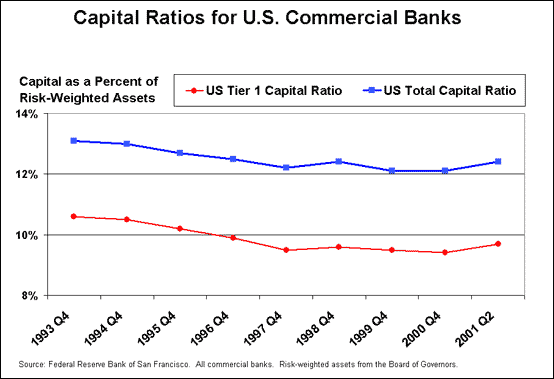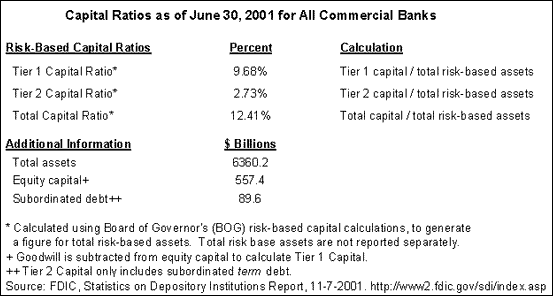[updated 03/2003]
Bank capital serves as an important cushion against unexpected losses. It creates a strong incentive to manage a bank in a prudent manner, because the bank owners’ equity is at risk in the event of a failure.1 Thus, bank capital plays a critical role in the safety and soundness of individual banks and the banking system.
Bank capital is often defined in tiers or categories that include shareholders’ equity, retained earnings, reserves, hybrid capital instruments, and subordinated term debt. Capital ratios are commonly measured as a percent of bank assets or risk-weighted bank assets. The chart below plots the behavior of two measures of U.S. commercial bank capital ratios over recent years.

Current Capital Requirements
The Basel Committee on Banking Supervision’s 1988 Capital Accord (Accord) sets capital requirements for major international banks from the G10 countries.2 The Accord became the model for risk-based capital standards for the U.S. the following year.3 The Accord requires international banks to
"…hold capital equal to at least 8% of a basket of assets measured in different ways according to their riskiness."4
Under the Accord, the riskier a bank’s portfolio, the more capital it would be required to hold.
The minimum 8 percent capital requirement for each bank may be met by holding two categories of capital, although at least half of a bank’s capital must be Tier 1 capital.5
- Tier 1 Capital is calculated as follows:
+ Permanent shareholders’ equity
+ Disclosed reserves (including retained earnings)
Less: Goodwill - Tier 2 Capital is calculated as follows:
+ General provisions/general loan-loss reserves
+ Revaluation reserves
+ Hybrid (debt/equity) capital instruments
+ Subordinated term debt
+ Undisclosed reserves (not allowed for U.S. banks)
Less: Investments in unconsolidated financial subsidiaries
Less: Investments in the capital of other financial institutions - Total Capital = Tier 1 Capital + Tier 2 Capital 6
These categories of capital are then divided by the sum of a bank’s risk-based assets to generate the appropriate risk-based capital ratios. The example below shows the risk-based capital ratios for the U.S. banking system.

The Accord created policy guidelines that each nation’s banking supervisors can follow to enhance the safety and soundness of the international banks they supervise. The Accord was designed to align regulatory capital requirements across nations-to "ensure an adequate level of capital in the international banking system," and to create a "more level playing field," across countries.7
A New Accord: BASEL II
Basel II, a new, more flexible, and risk-sensitive set of capital standards, has been proposed for final implementation at yearend 2006. The proposed standards will address some of the weaknesses of the 1988 Accord by creating a more risk-sensitive framework and improving risk measurement and management capabilities. For additional information, see the Basel Committee on Banking Supervision’s website at: http://www.bis.org/publ/bcbsca.htm
Endnotes
1. Loan loss reserves are generally intended to cover expected losses.
2. G-10 includes 11 industrialized nations: Belgium, Canada, France, Germany, Italy, Japan, the Netherlands, Sweden, Switzerland, United Kingdom, and United States.
3. The components may differ somewhat across countries; for example, U.S. banks may not hold undisclosed reserves.
4. Low (credit) risk assets, like cash or U.S. Treasury securities, have a 0 percent risk-weighted capital requirement. In contrast, claims on commercial companies and real estate investments have a 100 percent risk weight. For additional detail, see pages 21-22, International Convergence of Capital Measurement and Capital Standards, (1988).
5. For a discussion of additional limits, restrictions, and definitions of capital, see page 17, International Convergence of Capital Measurement and Capital Standards, (1988). Annex 1 provides a detailed description of the components of capital.
6. In addition, Tier 3 Capital is designed to cover market risk. Tier 1 Capital must be greater than the combined Tier 2 and Tier 3 Capital.
7. According to The New Basel Capital Accord: an explanatory note, (2001), page 11, "The major impetus for the 1988 Basel Capital Accord was the concern of the Governors of the G10 central banks that the capital of the world’s major banks had become dangerously low after persistent erosion through competition. Capital is necessary for banks as a cushion against losses and it provides an incentive for the owners of the business to manage it in a prudent manner."
References
International Converge of Capital Measurement and Capital Standards. Basel Committee on Banking Supervision. Basel, July 1988.
The New Basel Capital Accord: an explanatory note. (2001) Secretariat of the Basel Committee on Banking Supervision, January. 9-26-01. http://www.bis.org/publ/bcbsca01.pdf
The Federal Reserve System Purposes and Functions. (1994) Board of Governors of the Federal Reserve System, Washington, DC. See Chapter 5, Supervision & Regulation, pages 80-81. http://www.federalreserve.gov/pf/pf.htm